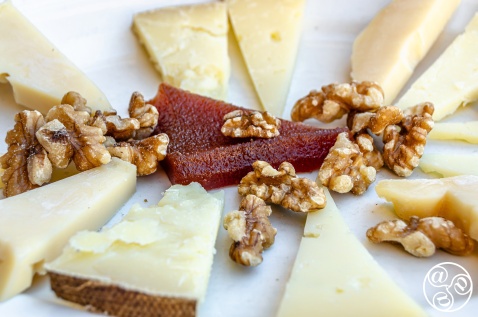
This Spanish delicacy of quince Jelly can be served with a wide variety of local cheeses |
|
Membrillo
Recipe By Katie O'Neill
Many visitors to Spain have never seen a quince fruit growing. The quince is a fragrant, yellow fruit that resembles a cross between an apple and a pear. Its tough, grainy flesh is typically too sour to eat raw, but when cooked, it transforms into a sweet, floral delicacy with a pinkish hue. Quince is often used in jams, jellies, and desserts, lending a rich flavor to various dishes. This ancient fruit has been cultivated for centuries and thrives in warm, temperate climates. In Spain, quince (known as "membrillo") is commonly grown and widely used to make the famous quince jelly, often paired with cheese.
The History of the quince
The quince has a rich history, dating back thousands of years to ancient civilizations. Originating in the Caucasus region and the Middle East, it was highly valued by the Greeks and Romans, who associated the fruit with love and fertility. In Greek mythology, quinces were often linked to Aphrodite, the goddess of love. The Romans spread quince cultivation throughout Europe, where it became a symbol of prosperity and luck. During the Middle Ages, quince was prized for its aromatic qualities and was often used in preserves. Its culinary popularity continued, especially in Spain and Portugal, where quince paste became a staple.
Quince Jelly Recipe
The quince fruit is almost too hard and bitter to eat as a raw fruit, however its high pectin content make it perfect for jams, jellies and chutnies. Quince Jelly can also be referred to as quince paste or (dulce de membrillo).
Recipe Ingredients:
- 1 ½ kg ripe quinces
- 1 ¼ kg sugar
- water
Method:
Wash the quinces and dry thoroughly with a cloth. Cut into chunks, removing the seeds and centre core, and place in a pot with just enough water to cover. Bring to a boil and then cook on medium heat, uncovered, until the fruit is quite tender.
Off the heat, use a hand blender to purée the fruit and then add the sugar. Return to the stove and cook on medium-high heat, stirring frequently, until it begins to thicken. Pour into individual serving dishes or a casserole dish or platter and let cool.
Serve with a cheese, or spread on bread as jam.
Serving suggestions
To serve quince with Spanish cheese, start by selecting a traditional cheese like Manchego, Idiazabal, or Cabrales, as their flavors pair well with quince's sweetness. Use membrillo (quince paste) and slice it thinly or into small cubes. For a tapas-style presentation, place the quince paste on thin slices of cheese and serve with crackers or toasted bread for added texture.
walnuts Enhance the dish by adding accompaniments like almonds, olives, or figs, which provide balance to the sweetness. For beverages, pair the quince and cheese with a Tempranillo, Cava, or sherry (like Fino or Amontillado) to elevate the flavors.
Arrange everything on a rustic wooden board for a simple yet elegant presentation. This combination of sweet quince and savory cheese creates a classic Spanish flavor pairing that works well for appetizers or social gatherings.
